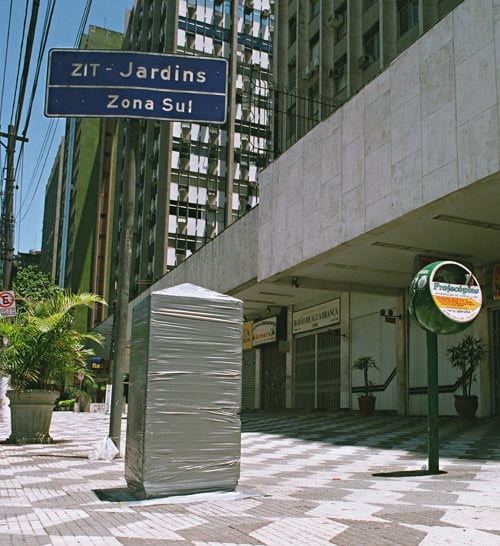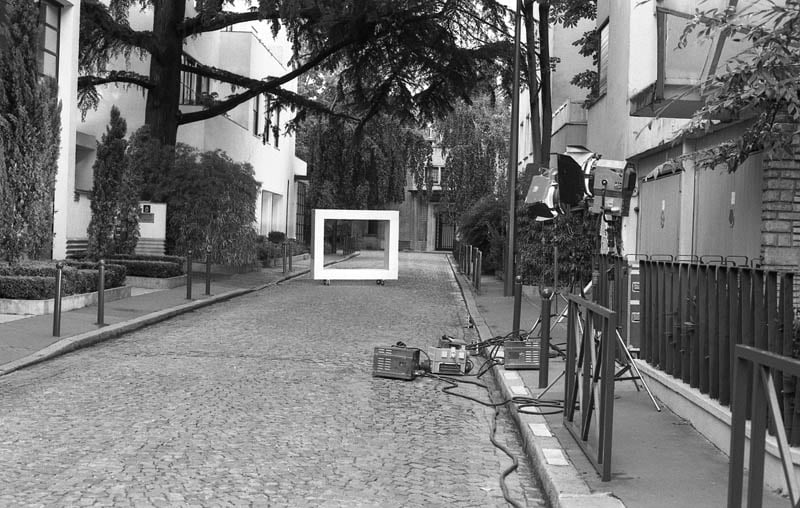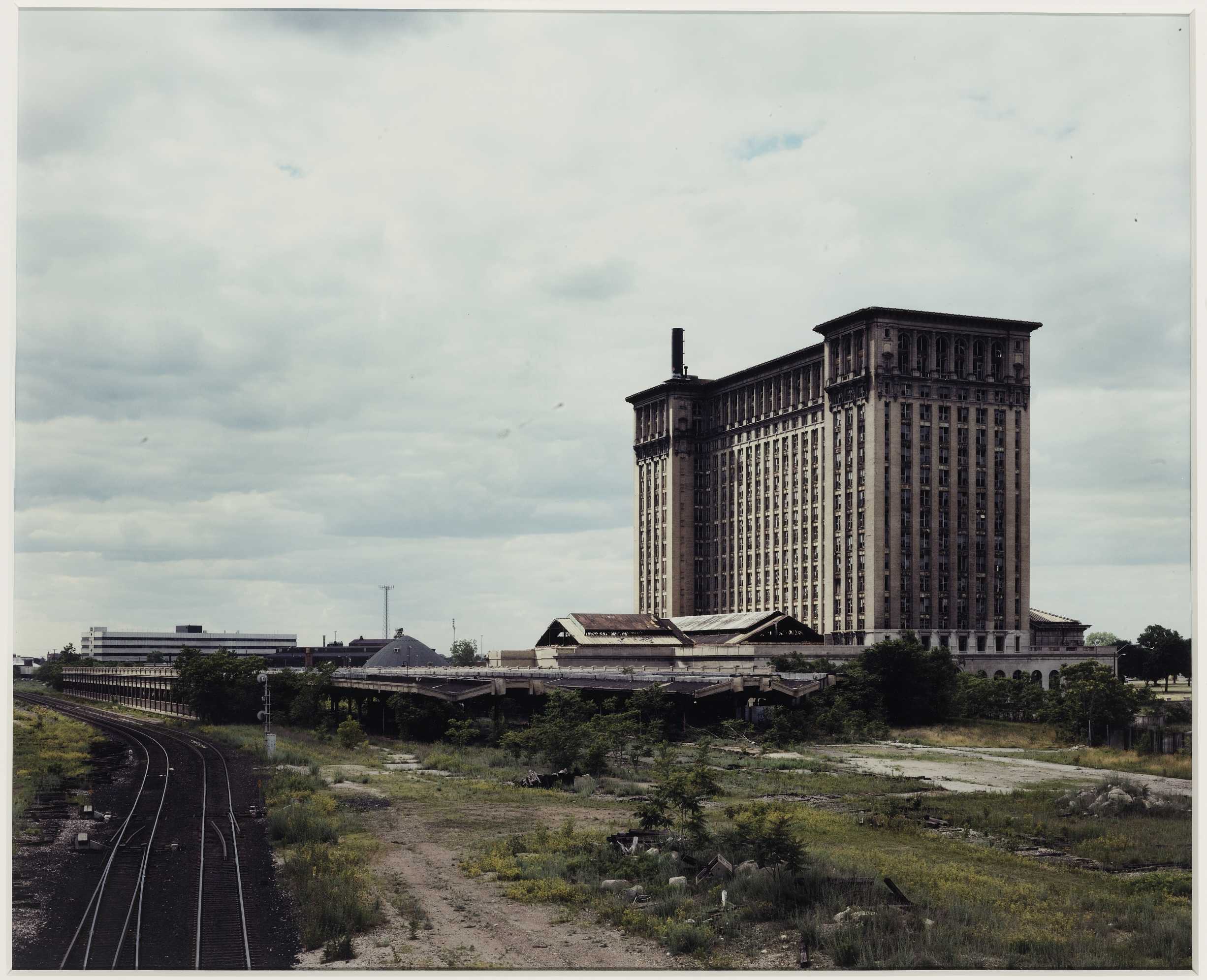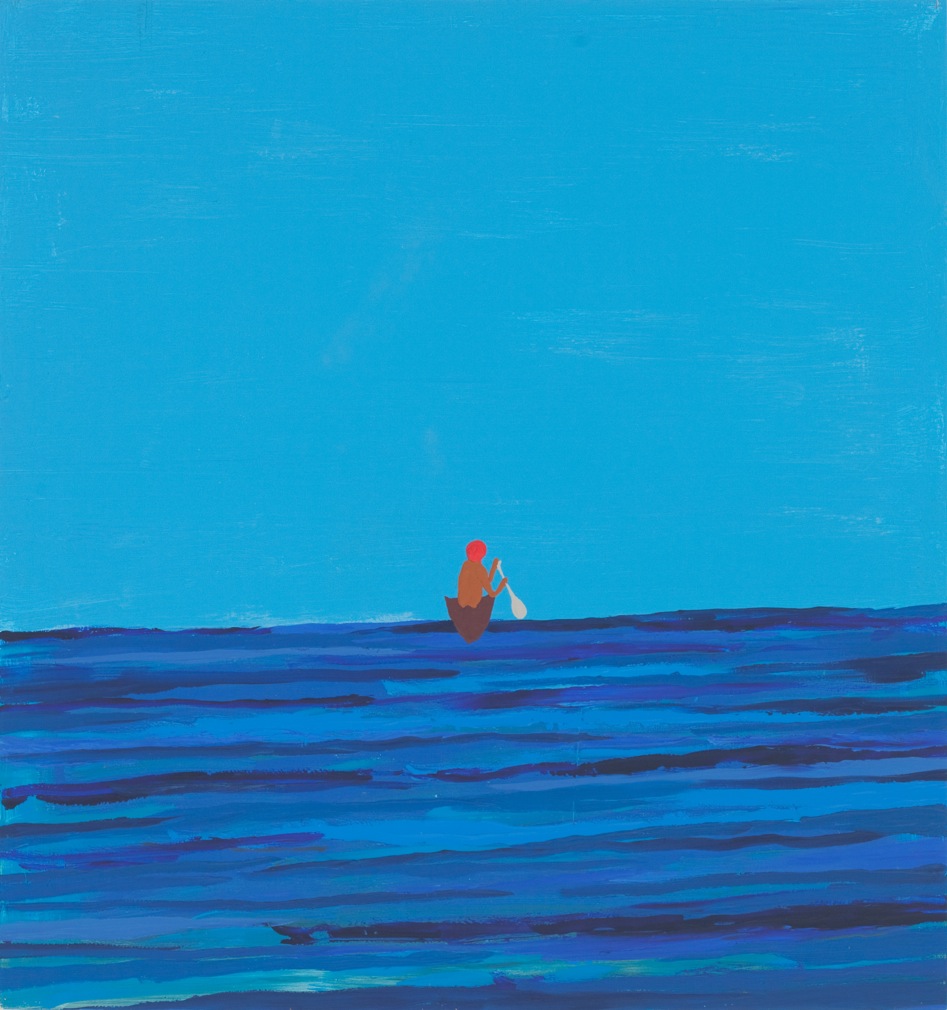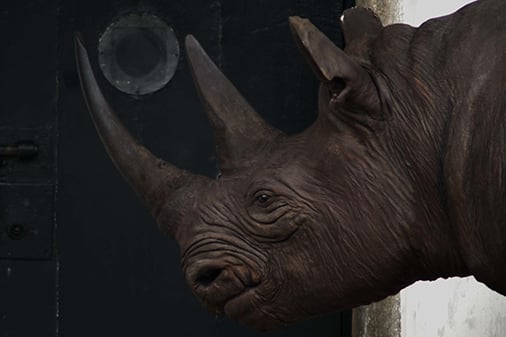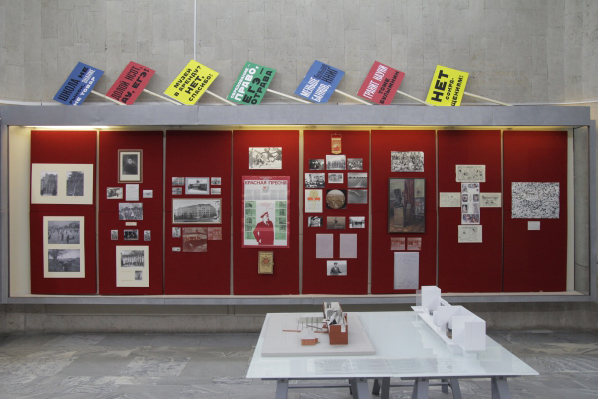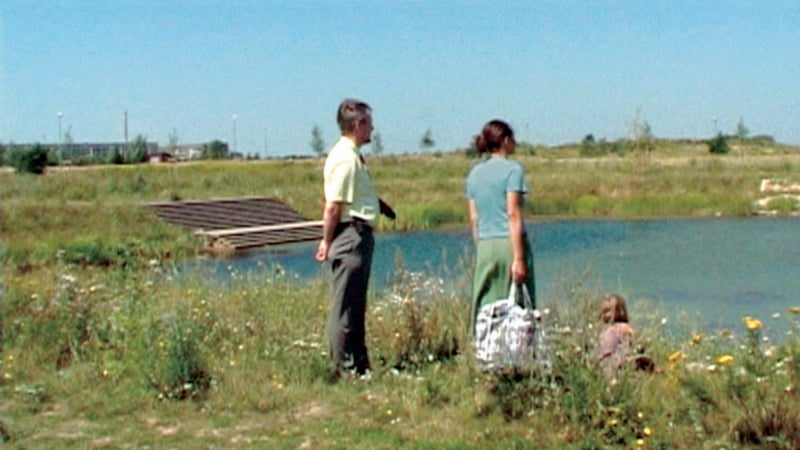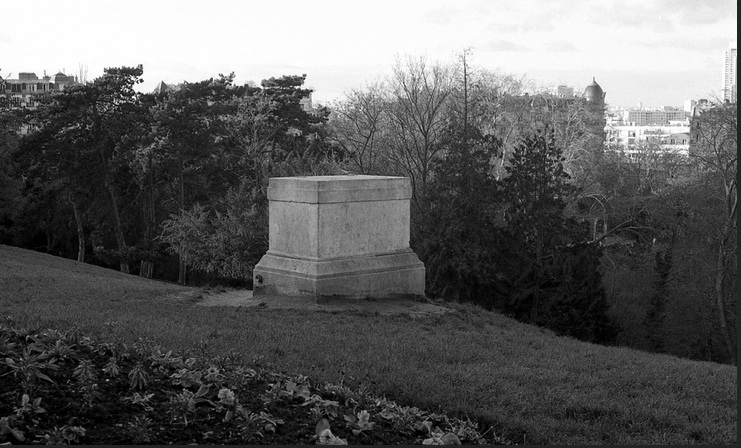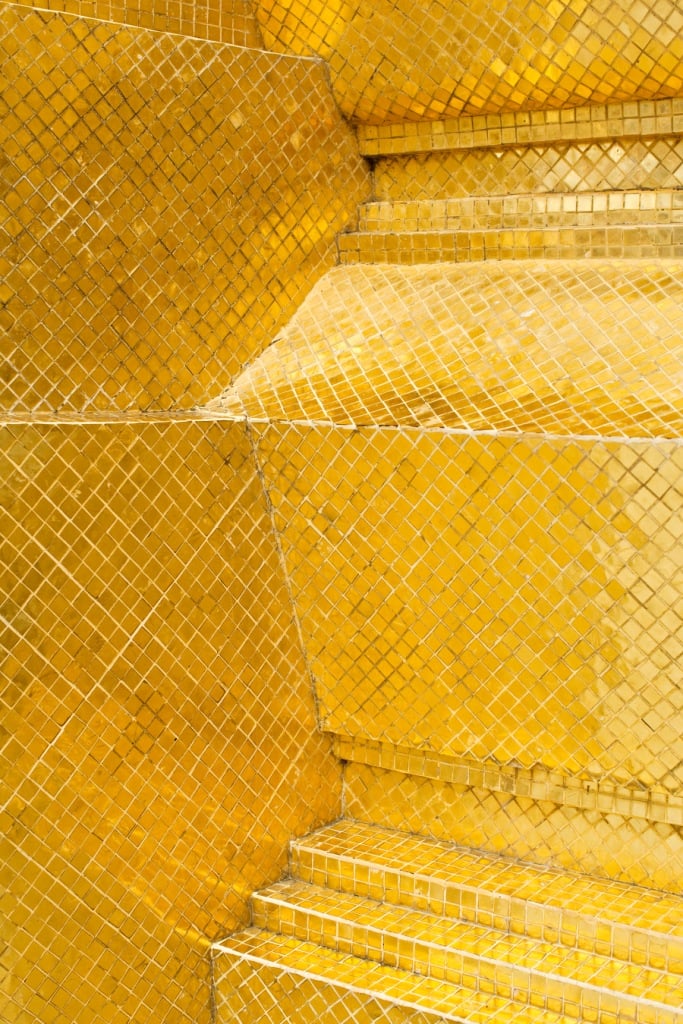
© » KADIST
Cao Shu
The installation Infinity and Infinity Plus One by Cao Shu is a modern fable of destruction, collective consciousness, and future memory told through the lens of a seaside hotel erected in the 1990s on an island in China. Combining 3D-rendered images and shot footage, the work travels through a seemingly-unlimited number of rooms, infinite corridors, and breathtaking viewpoints on site. Meanwhile, an official voiceover tells an absurd story about philosophy and mathematics in the form of a monologue.

© » KADIST
María Isabel Rueda
The Real. Retrato de Norman Mejía. (The Real. A Portrait of Norman Mejía.)

© » KADIST
Chantal Edie and Zacharie Ngnogue
Au non de la liberté (Tiko drink Kumba drunk) is a photographic series by Zacharie Ngnogue and Chantal Edie that considers the correlation between those who hold power in Cameroon and how their actions affect the populations they rule in often compromising ways. “Tiko drink-Kumba drunk” is an adage that is commonly used in the Southwest province of Cameroon to speak of how one’s actions affect others. Civil liberties are next to non-existent in Cameroon, the law is lawless, and structured in a way that is intended to attack its citizens’ human rights.

© » KADIST
Bahar Noorizadeh
The Red City of the Planet of Capitalism is part of a three project lineage, following Bahar Noorizadeh’s research on the architecture of the Soviet Union. The video focuses on the peculiar story of the Russian architect Moisei Ginzburg, who, in the late 1920s, suddenly turned his back on Le Corbusier, the French father of urbanist modernism. While Ginzburg had been a fervent follower of Le Corbusier’s philosophy, the story says that he was converted to disurbanism in only half an hour by the urban sociologist Mikhail Okhitovich.

© » KADIST
Nikita Gale
RUINER III by Nikita Gale is part of an on-going numbered series of abstract sculptures in which various ancillary materials necessary for sound production and recording such as towels, foam, and audio cables, are riddled around piping resembling crowd control bollards, lighting trusses, and other like stage architecture. While these muscular works evoke the forms and dynamism of mid-century modernism, they can also be seen as a translation of Goethe’s idea that “architecture is frozen music”. RUINER III is exemplary of how the artist’s disembodied sets typically evoke a sense of longing through absence, and in so doing, draw out an extended mediation on how audiences project mental or emotional energy onto a person, object, or idea.

© » KADIST
Edie Fake
Drawing & Print (Drawing & Print)
Related to Edie Fake’s Memory Palaces series — reimagined facades of urban lesbian bars and gay nightclubs — Personal Business draws an association between architecture and the body, with ornamental structures that are decorative and protective. Fake notes, “More and more I’m trying to bring an anarchy into that architecture, or a fantasy and ecstasy of what queer space is and can be.” A beautiful building that’s defended by an imposing front. In this way, the architecture becomes a metaphor for the constructed layers of the self.

© » KADIST
Nagendra Gurung
Chalis Katesi Ramaula is a series of 240 prints capturing Nagendra Gurung’s life, work, and colleagues from the construction sites where he has worked in Dubai and Saudi Arabia. When seen together, the sequence appears to have a cinematic temporality, as one feels the passing of the years he has endured as a migrant worker. Gurung’s subjectivity is highly present, even when looking at the most banal scenes of cranes, concrete, and other machinery, which are rapidly transforming the landscape and society of the Gulf into its own version of capitalist futurism built through the exploitation of others.

© » KADIST
Hulda Guzmán
Be Kind to Your Demons is a series of paintings by Hulda Guzmán that presents a variety of scenes in which female characters carry out ubiquitous activities in the company of secondary characters (mostly men) and devil-like creatures. Like much of her work, Be Kind to Your Demons is an invitation to embrace the devil in each of us, to surrender to bodily and external pleasures, and to engage in a conscious dialogue with our own existence. Guzmán’s paintings are a reminder of the brevity, potential intensity, and frailty of human existence.

© » KADIST
Beverly Buchanan
Made between 1986 and 2015, Buchanan’s Shack Sculptures are a result of the artist’s close observation and extensive research of ‘shotgun’ houses, where one room is arranged in sequence one behind the other; the rural poor inhabited these houses. They were often constructed for rent near railways or manufacturing centers, but by the late twentieth century tended to be owner-occupied. By engaging with this architectural form, Buchanan considers the economic consequences of the abandonment of this form of housing as a result of the ubiquity of the motorcar that permitted people to move to the suburbs, where there was less pressure on space.

© » KADIST
Basma Alsharif
Deep Sleep draws from historical avant-garde cinema to produce a poetic, sound-based meditation following brainwave-generating binaural beats. The dreamlike video is filmed among abandoned ruins in Malta, Athens, and Gaza, connecting the three locations in an attempt to convey the experience of being in Gaza from these monumental sites. Colorful flickering lights, sun, earth, stone, rock, sky, and water inundate the scenes, and the rhythmic sounds of waves, chimes, and footsteps remain.

© » KADIST
Shu Lea Cheang
Reflecting upon the transformation of surveillance techniques since the panopticon to include contemporary 3-D facial recognition, AI, and the Internet, Shu Lea Cheang’s 3x3x6 – 10 cases 10 data restages the rooms of the Palazzo delle Prigioni—a Venetian prison from the sixteenth century in operation until 1922—as a high-tech surveillance space. Taking as its starting point the story of libertine writer Giacomo Casanova, imprisoned in the Prigioni in 1755, Cheang has conducted in-depth studies on ten historical and contemporary cases of subjects incarcerated because of gender or sexual dissent, including the Marquis de Sade and Michel Foucault, as well as contemporary cases from Taiwan and South Africa. Their fictionalized portraits become part of the exhibition’s system; the title of which refers to today’s standardized architecture of industrial imprisonment: a 3 x 3 square-metre cell constantly monitored by 6 cameras.

© » KADIST
Vaclav Pozarek
Concerning his objects, Pozarek often relies on chance to guide him. He uses scraps of wood, boxes, hinges and doors, keeping a close eye on what position each object will assume later in the space. Although it suggests the opposite at first glance, Zwillinge is autonomous and functionless.

© » KADIST
Bettina Pousttchi
For Bettina Poutsttchi’s large-format, site-specific photographic work Echo (2009–10), the four exterior walls of the Temporäre Kunsthalle Berlin were covered with a digitally edited collage of archival images of the glass-and-steel facade of the Palast der Republik (Palace of the Republic), which had once been located nearby. That milestone of late East European modernism was completed in 1976. It served as the seat for the Volkskammer—the parliament of the German Democratic Republic (GDR).

© » KADIST
Ryan Villamael
Behold A City 4 extols the old grandeur of Manila, the nation’s storied capital – the complex nexus of heritage, modernity, and all sorts of compulsions, political or otherwise, that attempt to define it. This is not Manila whittled down to a scale model but a re-imagination of the city by Ryan Villamael in his ardor to approximate its complexity both as a physical, urban fact and an evolving concept. Behold A City 4 features an entirely new topography and arrangement.
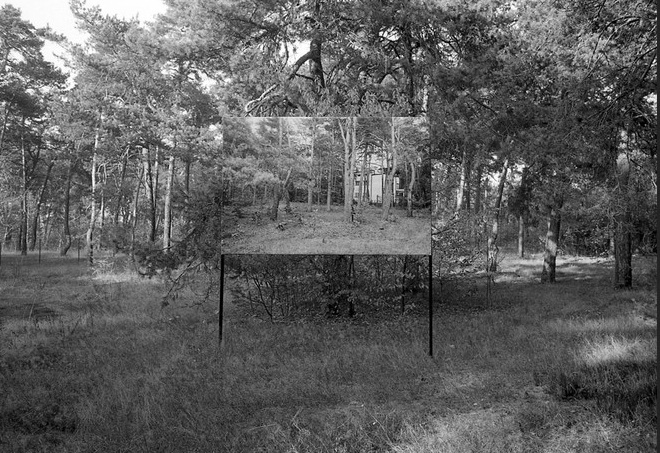
© » KADIST
Charlotte Moth
It is with the eye of a sculptor that Charlotte Moth records modernist architecture and its copies which she encounters during her trips and residences. Photographed in black and white, these architectures seem empty, out of time, and open to any interpretation. The artist creates a classification of her species of spaces, called the “Travelogue”, which is both artwork and tool since it allows her to ceaselessly generate new works.

© » KADIST
Raphaël Zarka
This photograph seems to be awaiting meaning, it more or less evokes known elements without really identifying with them completely: a motorway interchange, a bridge, an electric pylon… In fact this is the end of the tracks of the Aérotrain, a wheelless monorail invented by Jean Bertin in the 1970s, which acts like ‘a fossil of movement on landscape scale’, as explained by the artist. This fragmentary place is meant to activate physical movement. It also activates the spectator’s imagination.

© » KADIST
Allan deSouza
For the photographic series Rumpty Trumpty , in 1997, Allan deSouza photographed the Trump Taj Casino in Atlantic City, NJ, reprinting the images again in 2017, from digital scans of the negatives. These negatives bear the traces of extensive damage wrought over time. These dust damaged and scratched prints appear as aged and out of date as the orientalist fantasy that they depict.

© » KADIST
Diane Simpson
Simpson’s sculptural practice connects architecture, clothing, furniture and the body to explore the functional and sociological roles and the influence of the design and architecture of various cultures and periods in history. Her sculptures hold very specific references and are developed and transformed through revised drawings to create hybrid forms that are directed by her means of construction and choice of materials.
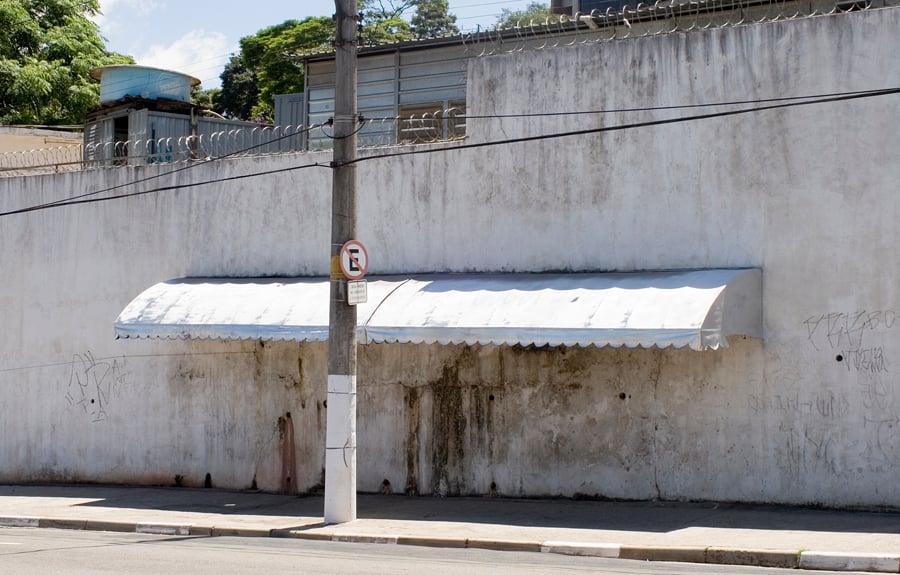
© » KADIST
Marcelo Cidade
This series of photographs reflects Marcelo Cidade’s incessant walks or drifting through the city and his chance encounters with a certain street poetry like the Surrealists or Situationists before him. He captures incongruities or everyday simplicity and highlights their suggestive power. The composition and framing of these interventions specially emphasizes the object of interest and the humor of the context.

© » KADIST
Valérie Jouve
Like many contemporary photographers who play with the codes of realism, Valérie Jouve composes her images, having already a more or less predetermined result in mind, in order to deliver a complex representation of the world instead of a bold presentation of facts. A part of the series “Les Figures”, this “portrait’ of P. Faure carries a strong ambiguity, typical of the photographer’s images, between realism and mise-en-scene . This photograph is exemplary of Valérie Jouve’s work: inscription of an inidual within an urban landscape, relation to architecture, simplicity of composition and strong, yet imprecise narrativity – related in part to seemingly familiar characters or places.

© » KADIST
Marc Nagtzaam
Drawing & Print (Drawing & Print)
Nagtzaam’s medium is drawing and his repertory of forms varies from abstract hard-edge and wall drawing to the reproduction of written material that he collects from art magazines. The artist uses abstract architectural elements that he reproduces on the wall in which he inserts drawings, elements from photographs and drawings of texts collected from art magazines. The repetition, control and imperfection of the movements create a tension, a particular vibration in his geometrical drawings and in the drawings of texts.

© » KADIST
Curtis Talwst Santiago
Curtis Talwst Santiago has been creating intimate and performative environments within these small spaces for several years; the artist used to carry them around to show visitors one on one, opening up a scene in the space of his hand. Santiago considers these mobile box enclosures a method of transporting narratives of home and intimacy, diasporic identity, and experiences most often hidden or concealed from view. These Walls is a sculptural piece made from a reclaimed jewelry box, clay, paint, wool, plastic figurines, and human hair.

© » KADIST
Majd Abdel Hamid
Tadmur by artist Majd Abdel Hamid is influenced by a book by Mustafa Khalifa titled The Shell: Memoirs of a Hidden Observer , which details Khalifa’s imprisonment in the Assad ‘desert prison’ Tadmur. Khalifa’s compelling testimonial is now considered to have enlightened the Syrian public to the atrocities being committed in their country by the Assad regime and catalyzed a political resurgence in Syria. The prison was destroyed by ISIS in 2015 and though the initial reaction by the Syrian public was largely positive, the complete leveling of the prison erases the brutal experiences of the prisoners, many of whom died and those that survived.

© » KADIST
Chantal Edie and Zacharie Ngnogue
Au non de la liberté (Tiko drink Kumba drunk) is a photographic series by Zacharie Ngnogue and Chantal Edie that considers the correlation between those who hold power in Cameroon and how their actions affect the populations they rule in often compromising ways. “Tiko drink-Kumba drunk” is an adage that is commonly used in the Southwest province of Cameroon to speak of how one’s actions affect others. Civil liberties are next to non-existent in Cameroon, the law is lawless, and structured in a way that is intended to attack its citizens’ human rights.
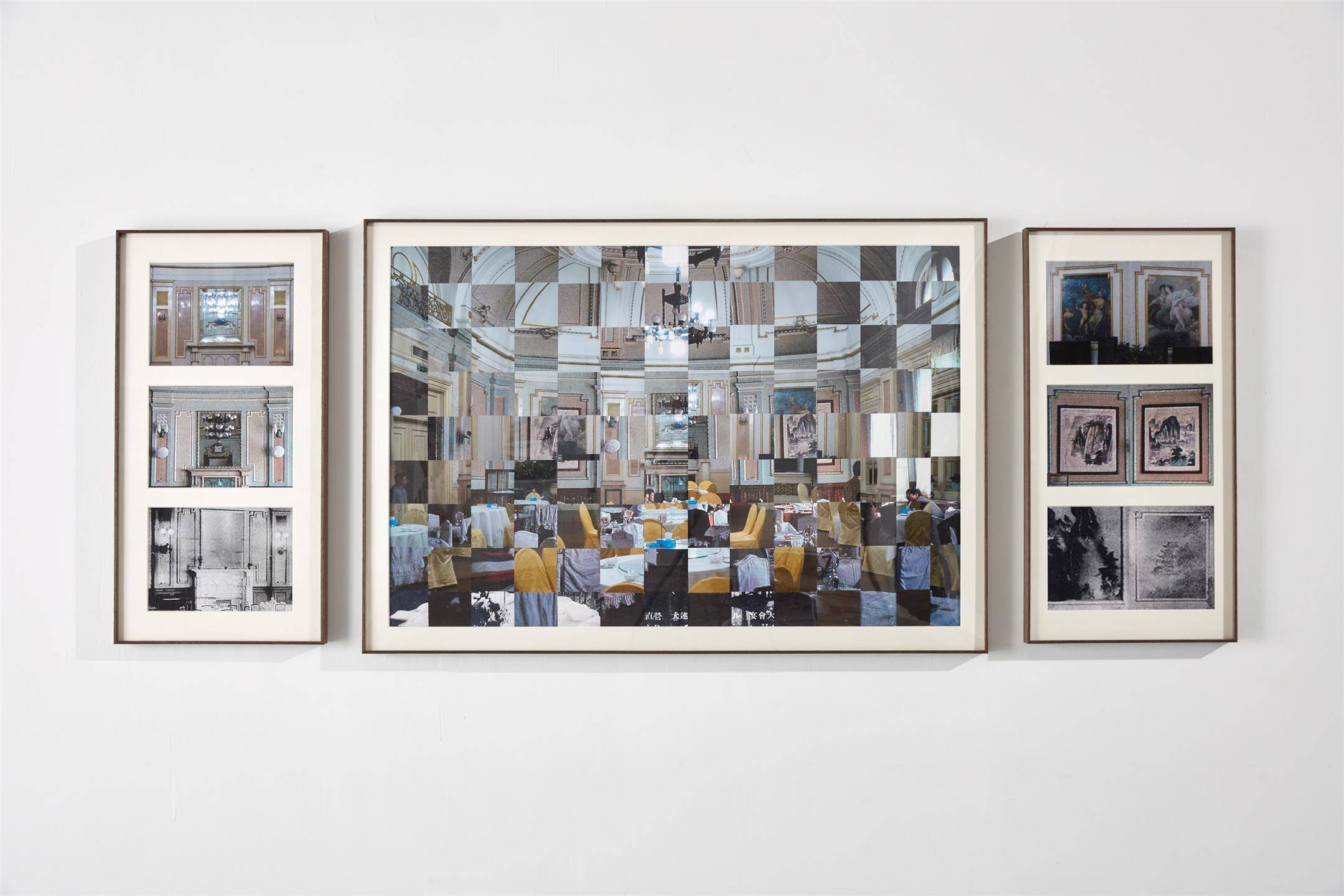
© » KADIST
Luka Yuanyuan Yang
Composed of three photographic panels, Three Times at Yamato Hotel by Luka Yuanyuan Yang is a part of the artist’s ongoing project Dalian Mirage , a seven act play in a theatre staged as the city of Dalian. This modern city was built by the Russian Empire in 1898 and occupied by Japan between 1905 and 1945. Based on historical investigations, Yang created ten characters, including a Dalian-born Japanese writer and a Dalian-born American immigrant.

© » KADIST
Chantal Edie and Zacharie Ngnogue
Au non de la liberté (Tiko drink Kumba drunk) is a photographic series by Zacharie Ngnogue and Chantal Edie that considers the correlation between those who hold power in Cameroon and how their actions affect the populations they rule in often compromising ways. “Tiko drink-Kumba drunk” is an adage that is commonly used in the Southwest province of Cameroon to speak of how one’s actions affect others. Civil liberties are next to non-existent in Cameroon, the law is lawless, and structured in a way that is intended to attack its citizens’ human rights.

© » KADIST
Juan Araujo
Drawing & Print (Drawing & Print)
Many of Araujo’s works depict reproductions and Libro Ponti II is a recreation of a book on Italian architect Gio Ponti. Ponti designed the Villa Planchart a private, modernist house in Caracas, Venezuela, which at the time it was built in 1956, reflected the emergence of a class increasingly globalized, both culturally and economically. Araujo’s replica of the book thus refers to the role and visibility of Venezuela in circuits of global cultural production.

© » KADIST
William E. Jones
His series, The Golden State, harkens back to his early career and his photographic training. Using a still camera to compose the fifty images of the series, Jones turns his lens on the vernacular architecture of California’s southern region, looking at the iconic and idiosyncratic spaces that define a region. William E. Jones is a filmmaker, writer, and artist whose interests lie in the circulation of images—images that are broadcast, images that are hidden, and images that become imbedded in our collective consciousness.

© » KADIST
Diego Marcon
Monelle by Diego Marcon was filmed at night inside the infamous Casa del Fascio, the headquarters of the local Fascist Party in Como Italy, designed by Giuseppe Terragni under Mussolini’s rule. The building is immersed in darkness and it is initially difficult to recognize the iconic rationalist architecture, flashes of light illuminate languid adolescent girls sleeping amidst the space for just a few seconds at a time. Next to the bodies, strange humanoids are lurking, they are CGI-generated, but the human eye does not have enough time to register their artificiality, they materialize and disappear in a flash like ghosts.
Juan Araujo
- year born: 1971
- gender: male
- nationality: Spanish
- home town: Caracas, Venezuela
Chantal Edie and Zacharie Ngnogue
Chantal Edie and Zacharie Ngnogue are a photography duo who channel their personal experiences into social commentaries...
Rocky Cajigan
Rocky Cajigan is a Bontoc Igorot artist working in the contemporary contexts of Indigenous people from the Cordilleras region in the northern state of Luzon island in the Philippines...
Luisa Lambri
- location: Los Angeles, California
- year born: 1969
- gender: female
- nationality: Italian
- home town: Como, Italy
Chris Wiley
- location: New York, New York
- year born: 1981
- gender: male
- nationality: British
Charlotte Moth
Charlotte Moth has been constituting an image bank since 1999...
Nora Schultz
Born 1975, Frankfurt / Main, Germany Lives and works in Berlin Nora Schulz explores the relations between painting, sculpture, performance, and language...
Beverly Buchanan
Beverly Buchanan initially trained as a public health educator having studied medical technology and came to art later, training at the Art Students League under Norman Lewis and finding mentorship in Romare Bearden...
Adrien Missika
Adrien Missika (1981, Paris, France) studied and developed his career in Lausanne where he founded 1m3 artspace...
Stan Douglas
- location: Vancouver, Canada
- year born: 1960
- gender: male
- nationality: Canadian
- home town: Vancouver, Canada
Cao Shu
Cao Shu’s works span three-dimensional digital moving images, sound installation, and interactive games...
Sung Hwan Kim
In his practice, Sung Hwan Kim assumes the role of director, editor, performer, composer, narrator, and poet...
Marc Nagtzaam
1968, Helmond, the Netherlands...
Camel Collective
Camel Collective comprises the artists Carla Herrera-Prats (Mexican, photographer and conceptual artist) and Anthony Graves (American, painter), who began working together in 2005 during a fellowship at the Whitney Independent Program...
Luka Yuanyuan Yang
Luka Yuanyuan Yang is a photographer, filmmaker and visual artist based in Beijing...
Curtis Talwst Santiago
Curtis Talwst Santiago is a multimedia artist making work centered on the diasporic experience, transculturalism, and memory...
Marlon de Azambuja
Based on ideas of architecture, and by means of appropriation of public space and studio-based material operations, Marlon de Azambuja’s work creates new idioms for thinking and inhabiting the built environment...
Hassan Massoudy
Hassan Massoudy trained as a classical calligrapher in Baghdad before attending the Ecole des Beaux-Arts in Paris in 1969...
Louisa Bufardeci
Louisa Bufardeci is fascinated by the way our world is visually materialized through data measurement...
Clemens von Wedemeyer
- location: Göttingen, Deutschland
- year born: 1974
- gender: male
- nationality: German
Meschac Gaba
born in 1961 in Cotonou, Benin...
Chris Johanson
- location: Los Angeles, California
- year born: 1968
- gender: male
- nationality: American
- home town: San Jose, California
Diane Simpson
Diane Simpson is interested in a seamless shifting from body to architectural form in the melding of the wearable with the structural un-wearable...
Sammy Baloji
Sammy Baloji explores the cultural, architectural and industrial heritage of the Katanga region in Congo...
Oliver Beer
The work of Oliver Beer explores the resonances in buildings and objects, exploiting the occurrence of natural frequencies that turn buildings and objects not only into amplifiers but musical instruments...
Gabriel Sierra
Colombian artist Gabriel Sierra’s work lies in the intersection between art and design...
-
1930-1939
Tina Modotti
1930The Italian photographer Tina Modotti is known for her documentation of the mural movement in Mexico...
-
1990-1999
Catherine Opie
1994Although best known as a provocateur and portraitist, Opie also photographs landscapes, cityscapes, and architecture...
Stan Douglas
1997Michigan Central Station is part of a larger photographic series, Detroit Photos , which includes images of houses, theaters, stadiums, offices, and other municipal structures...
-
2000-2009
Valérie Jouve
2000Like many contemporary photographers who play with the codes of realism, Valérie Jouve composes her images, having already a more or less predetermined result in mind, in order to deliver a complex representation of the world instead of a bold presentation of facts...
William E. Jones
2000His series, The Golden State, harkens back to his early career and his photographic training...
Chris Johanson
2000Apartment on Cardboard (2000) is an exterior view of an abstracted apartment building...
Raphaël Zarka
2001This photograph seems to be awaiting meaning, it more or less evokes known elements without really identifying with them completely: a motorway interchange, a bridge, an electric pylon… In fact this is the end of the tracks of the Aérotrain, a wheelless monorail invented by Jean Bertin in the 1970s, which acts like ‘a fossil of movement on landscape scale’, as explained by the artist...
Luisa Lambri
2002Lambri’s careful framing in Untitled (Miller House, #02) redefines our understanding of this iconic mid-century modernist building located in Palm Springs, California...
Clemens von Wedemeyer
2004Die Siedlung is a filmic documentary about the recent shift in housing developments in Leipzig-Grünau in former East Germany and its consequences on some inhabitants...
Abraham Cruzvillegas
2004Wright Imperial Hotel (2004) is a sort of bow and arrow made out of feathers, a São Paulo phone book, and other materials...
Nagendra Gurung
2005Chalis Katesi Ramaula is a series of 240 prints capturing Nagendra Gurung’s life, work, and colleagues from the construction sites where he has worked in Dubai and Saudi Arabia...
Marcelo Cidade
2006This series of photographs reflects Marcelo Cidade’s incessant walks or drifting through the city and his chance encounters with a certain street poetry like the Surrealists or Situationists before him...
Juan Araujo
Drawing & Print
2006(Drawing & Print) Many of Araujo’s works depict reproductions and Libro Ponti II is a recreation of a book on Italian architect Gio Ponti...
Sung Hwan Kim
2007An early work in Sung Hwang Kim’s career, the video Summer Days in Keijo—written in 1937 is a fictional documentary, the film is based on a non-fiction travelogue, In Korean Wilds and Villages , written by Swedish zoologist Sten Bergman, who lived in Korea from 1935 to 1937...
Luisa Lambri
2007Custom-built for a silent film star in 1934 in Santa Monica, the Sten-Frenke House is an idiosyncratic icon...
Hassan Massoudy
Drawing & Print
2008(Drawing & Print) Ranging from Baudelaire to the Koran, each of Hassan Massoudy’s drawings are titled with a quotation from a text...
Bettina Pousttchi
2009For Bettina Poutsttchi’s large-format, site-specific photographic work Echo (2009–10), the four exterior walls of the Temporäre Kunsthalle Berlin were covered with a digitally edited collage of archival images of the glass-and-steel facade of the Palast der Republik (Palace of the Republic), which had once been located nearby...
Jean-Luc Moulène
2009Head Box by J ean-Luc Moulène i s not the representation of a space but a real space that remains in the domain of sculpture which the artist develops in parallel with his photographic practice...
-
2010-2019
Tamar Guimarães
2010Canoas by Tamar Guimarães is a film made for the 2010 São Paulo biennial as an exercise in the projection of national identity...
Takahiro Iwasaki
2010Tectonic Model is made from a number of leather bound books piled up in different formations that resemble architecture on top of a sawhorse desk...
Meschac Gaba
2010The headdresses, woven from artificial hair braids, symbolize historical icons including Martin Luther King, Kwame Nkrumah, Fela Kuti and King Guézo of Dahomey...
Tomoko Yoneda
2010Yoneda’s Japanese House (2010) series of photographs depicts buildings constructed in Taiwan during the period of Japanese occupation, between 1895 and 1945...
Carlos Garaicoa
2010From the series the Old and the New (XI) by Carlos Garaicoa belongs to the series Lo viejo y lo nuevo / Das Alte und das Neue (The Old and the New) which was first exhibited in 2010 at Barbara Gross Gallery in Germany...
Oliver Beer
2011Pay and Display is a film of a performance, for which there was no audience, staged in the multistory Pershore Street car park in Birmingham, a brutalist building, arguably one of the most inhospitable environments for a musical performance...
William E. Jones
2011In the early 20th century, the Hercules Engine Company was doing a brisk business producing customized, heavy-duty engines...
William E. Jones
2011In Restaurant, Canton, Ohio (2011), a convenience store offers food, liquor, and Coca Cola to an empty street...
Charlotte Moth
2012It is with the eye of a sculptor that Charlotte Moth records modernist architecture and its copies which she encounters during her trips and residences...
Diane Simpson
2012Simpson’s sculptural practice connects architecture, clothing, furniture and the body to explore the functional and sociological roles and the influence of the design and architecture of various cultures and periods in history...
Charlotte Moth
2012It is with the eye of a sculptor that Charlotte Moth records modernist architecture and its copies which she encounters during her trips and residences...
Daniela Ortiz
2012In her work, Maids Room (2012) which is part of a series, Daniela Ortiz undertakes an architectural analysis of the houses belonging to the upper class of Lima...
Chris Wiley
2012Architectural details become abstracted renderings in Chris Wiley’s inkjet prints 11 and 20 (both 2012)...
Chris Wiley
2012Architectural details become abstracted renderings in Chris Wiley’s inkjet prints 11 and 20 (both 2012)...
Nora Schultz
2013Halfway between a painting and an installation City Sound of Rug gathers found images, synthetic foam, painted metal plates, and prints placed on the floor...
Adrien Missika
2013Adrien Missika follows in the footsteps of the Brazilian landscape architect and artist Roberto Burle Marx (1909-1994), a designer of gardens, parks and promenades who introduced modern landscape architecture to Brazil...
Basma Alsharif
2014Deep Sleep draws from historical avant-garde cinema to produce a poetic, sound-based meditation following brainwave-generating binaural beats...
Marc Nagtzaam
Drawing & Print
2014(Drawing & Print) Nagtzaam’s medium is drawing and his repertory of forms varies from abstract hard-edge and wall drawing to the reproduction of written material that he collects from art magazines...
Oscar Tuazon
2014Oscar Tuazon‘s sculptural oeuvre is situated at the border of art, architecture and technology...
Edie Fake
Drawing & Print
2015(Drawing & Print) Related to Edie Fake’s Memory Palaces series — reimagined facades of urban lesbian bars and gay nightclubs — Personal Business draws an association between architecture and the body, with ornamental structures that are decorative and protective...
Jill Magid
2016In 1995, the personal and professional archives of the Mexican architect Luis Barragán were acquired (including the rights to the name and the work of the architect) by the Swiss furniture enterprise Vitra...
Beverly Buchanan
2017Made between 1986 and 2015, Buchanan’s Shack Sculptures are a result of the artist’s close observation and extensive research of ‘shotgun’ houses, where one room is arranged in sequence one behind the other; the rural poor inhabited these houses...
Curtis Talwst Santiago
2017Curtis Talwst Santiago has been creating intimate and performative environments within these small spaces for several years; the artist used to carry them around to show visitors one on one, opening up a scene in the space of his hand...
Diego Marcon
2017Monelle by Diego Marcon was filmed at night inside the infamous Casa del Fascio, the headquarters of the local Fascist Party in Como Italy, designed by Giuseppe Terragni under Mussolini’s rule...
Rocky Cajigan
2017From the Ending by Rocky Cajigan consists of an assemblage painting, with accompanying sculptural objects presented on the floor...
Rocky Cajigan
2017From the Beginning by Rocky Cajigan consists of an assemblage painting, with accompanying sculptural objects presented on the floor...
Marlon de Azambuja
2017Following a series of related works, Brutalismo Americano by Marlon de Azambuja is a site-specific sculptural installation produced during the artist’s residency at Kadist, San Francisco in 2017...
Clarissa Tossin
2017Clarissa Tossin’s film Ch’u Mayaa responds to Frank Lloyd Wright’s Hollyhock House (constructed 1919–21) in Los Angeles, an example of Mayan Revival architecture...
Hulda Guzmán
2018Be Kind to Your Demons is a series of paintings by Hulda Guzmán that presents a variety of scenes in which female characters carry out ubiquitous activities in the company of secondary characters (mostly men) and devil-like creatures...
Camel Collective
2018Gated Commune , a video by Camel Collective, is a critique of the complex, and often obtuse, language used to describe sustainable development projects...
Shu Lea Cheang
2019Reflecting upon the transformation of surveillance techniques since the panopticon to include contemporary 3-D facial recognition, AI, and the Internet, Shu Lea Cheang’s 3x3x6 – 10 cases 10 data restages the rooms of the Palazzo delle Prigioni—a Venetian prison from the sixteenth century in operation until 1922—as a high-tech surveillance space...
Ryan Villamael
2019Behold A City 4 extols the old grandeur of Manila, the nation’s storied capital – the complex nexus of heritage, modernity, and all sorts of compulsions, political or otherwise, that attempt to define it...
Majd Abdel Hamid
2019Tadmur by artist Majd Abdel Hamid is influenced by a book by Mustafa Khalifa titled The Shell: Memoirs of a Hidden Observer , which details Khalifa’s imprisonment in the Assad ‘desert prison’ Tadmur...
Luka Yuanyuan Yang
2019Composed of three photographic panels, Three Times at Yamato Hotel by Luka Yuanyuan Yang is a part of the artist’s ongoing project Dalian Mirage , a seven act play in a theatre staged as the city of Dalian...
-
2020-2029
Chantal Edie and Zacharie Ngnogue
2020Au non de la liberté (Tiko drink Kumba drunk) is a photographic series by Zacharie Ngnogue and Chantal Edie that considers the correlation between those who hold power in Cameroon and how their actions affect the populations they rule in often compromising ways...
Nikita Gale
2020RUINER III by Nikita Gale is part of an on-going numbered series of abstract sculptures in which various ancillary materials necessary for sound production and recording such as towels, foam, and audio cables, are riddled around piping resembling crowd control bollards, lighting trusses, and other like stage architecture...
Chantal Edie and Zacharie Ngnogue
2020Au non de la liberté (Tiko drink Kumba drunk) is a photographic series by Zacharie Ngnogue and Chantal Edie that considers the correlation between those who hold power in Cameroon and how their actions affect the populations they rule in often compromising ways...
Chantal Edie and Zacharie Ngnogue
2020Au non de la liberté (Tiko drink Kumba drunk) is a photographic series by Zacharie Ngnogue and Chantal Edie that considers the correlation between those who hold power in Cameroon and how their actions affect the populations they rule in often compromising ways...
Oren Pinhassi
2020Oren Pinhassi’s work examines the relationship between the human figure and the built environment...
Patricia Esquivias
2020Cardón Cardinal by Patricia Esquivias is part of a series of video works in which the artist develops a narrative in front of her computer screen...
Bahar Noorizadeh
2022The Red City of the Planet of Capitalism is part of a three project lineage, following Bahar Noorizadeh’s research on the architecture of the Soviet Union...



